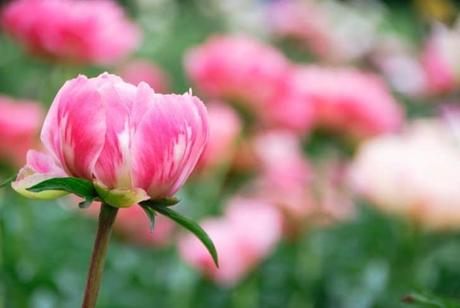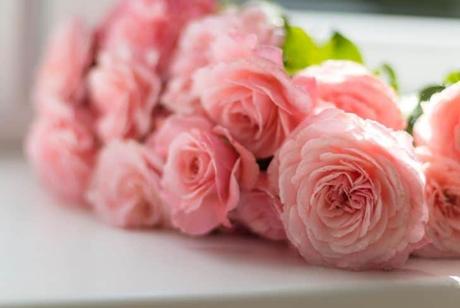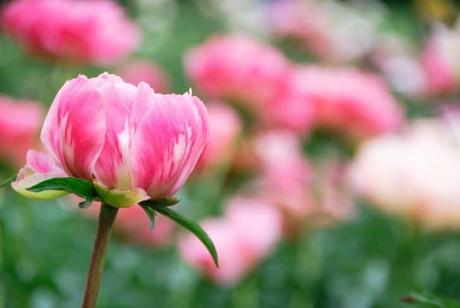When Do Peonies Bloom?
If you have planted peonies in your home garden, you might as well wonder when exactly to expect their beautiful blooms. Well, luckily for you, we have this covered! In this article, we will discuss all about peonies and their blooming season. So, by the time you reach the end of this article, you will have a clear idea of caring for these plants and nurturing their blooms, the right way!

Peonies are usually known to bloom during the late spring months. In some instances, you may also witness blooms during early summer. Unfortunately, despite these pretty blooms, the flowers of peonies barely last for a week to 10 days. They usually do not flower simultaneously, and their bloom time is classified from early to late seasons.
In case you want your garden to consistently feature the blooms from peonies consider planting multiple species of the plant. Also, note that the exact time when your peonies will bloom entirely depends on your region’s climate. The plant thrives better in cooler weather and it does really well in hardiness zones ranging from 3 to 8.
Do Peonies Bloom More Than Once?
Conventional garden peonies do not feature woody stems. Although some species of herbaceous peonies tend to exhibit new growth at the beginning of each season, your regular garden-variety peonies will only bloom once a year.
In most instances, you won’t manage to witness another round of blooms after cutting the first set of peonies. However, you can always extend the life of the blooms by cutting the peonies at the right time. When you cut these flowers right before their blooming season, the flowers are more likely to be adversely impacted throughout the whole season.
Do Peonies Bloom in Their First Year?
Although peonies generally don’t bloom in the first year, in some rare scenarios you may witness one or two tiny flowers. Ideally, it takes around 2 to 3 years for peonies to beautifully bloom. It is only at this stage that you witness a spectacular display of blooms. Interestingly, the moment your peonies start blooming, you can expect to witness an entire lifetime of pretty flowers.
These plants will barely need any divisions. In case a certain clump gets excessively large for the space in question or in case you are looking to share the plants with friends, make sure you divide the flowers during the fall months.
To do this, just cut a part of the foliage and gently lift the whole plant from the ground. Now, take a sharp knife for cutting some parts of the plant. Here, you should focus on creating generous root clumps with around three to five eyes against each clump. Repot the plant in the hole and avoid breaking the roots as they are still quite brittle at this stage.
After this, you might want to water the plant thoroughly to ensure the moisture has seeped into the end of the hole. This will also ensure that the soil perfectly settles along the roots. If you divide the plants in the fall months, they aren’t likely to bloom in the coming spring. However, you can expect it to resume normalcy the following season.
To ensure that your peonies bloom consistently, make sure you apply quality all-purpose fertilizer at least once a year. Team this up with a compost dressing to ensure the proper health of your peonies. In case you end up mulching the flower beds excessively, make sure that mulch is not in proximity to your peonies’ base. In case the base comes in contact with mulch, its bloom will be directly affected and you won’t find any new flowers the following season.
What Season Do Peonies Bloom?
Peonies are generally known to bloom between late summer and spring. However, this will entirely depend on your location, the species of peonies, the growing conditions, and more. If you’re looking to stretch the season of peonies for a couple of weeks, we recommend planting the mid and late-season varieties.
How Do You Keep Peonies Blooming all Summer?
If you really want your peonies to bloom throughout the year, make sure you cut them at the right time. Ideally, you should cut the plant right after fall to render a perfect shape. Remember, even if you get a tad bit late, the plant might be eventually ruined by frostbite. While cutting the plant, make sure you clip the stems to the ground as much as you can.
Like many garden variety peonies, the ones at your home are likely to be stocky with fairly tiny flowers if you cut them off earlier than usual. To make the blooms last, precisely cut the big buds right at the stem’s tip. Next, try encouraging the tinier buds to move down every stem. This form of pruning is known as disbudding and it has time and again proved to be an excellent way to preserve the beautiful blooms.
1. Work on the Staking
Another thing you might have to consider is the staking requirements. Certain peonies might need staking especially if their heads are heavy and tend to flop by. However, you will always find a bunch of variants that will consistently maintain a proper shape without needing any extra support.
After potting your plants, fertilize them at least once a year (ideally during fall). You might also want to add another dose of fertilizer in the spring months when you start witnessing the first few shoots.

2. Water Peonies Regularly
Water the plant regularly, especially during droughts. The watering requirements are even higher for younger peonies, so it is always best to keep this factor in mind. When the peonies finally bloom, prune them and steadily remove the used flowers. This way, you get to completely ensure that the plants aren’t wasting their energy in creating new seed pods.
Finally, during the fall months, when the foliage of the peonies gradually takes a brownish hue, cut your peonies back into the ground and get rid of the excess foliage.
3. Work on the Air Circulation Requirements
Peonies are known to be a tough variant of plants with only a handful of natural ailments. However, one ailment that your plant might be susceptible to the Botrytis. Popularly known as the gray mold, Botrytis barely has a reputation of killing, but it can potentially damage your blooms, reduce their number, and steadily weaken your plant. Common signs of this ailment include fully blackened buds that create a kind of black spot on your leaves. This further affects the young shoots and causes them to rot. Eventually, the black parts will soften and be completely covered with greyish mold.
Unfortunately, this is a disease is known to be common, especially if your plant is positioned in a cool and damp zone. To make things worse, there may not be any visible signs of infection for one entire year. The best way to avoid this problem is by preventing its possibility in the first place. To do this, always ensure that your peonies receive ample sunlight and go the extra mile to check if they are being crowded by surrounding perennials.
Several years back, gardeners would plant the peonies at a stretch for creating a completely free-standing hedge. We would recommend you follow the same route for ensuring proper and consistent air circulation. Never plant peonies against fences or buildings for that extra protection.
What To Do For a Peony That Does Not Bloom?
There might be instances when your peonies won’t end up blooming regardless of your efforts. While many gardeners attribute this issue to the buds, it is not necessarily the absence of buds that creates the issue. Instead, in most cases, the issue is with buds not opening.
Even in healthy plants, you might find the buds first developing and then gradually taking a brownish hue and shriveling up. However, this issue does have a solution and you might want to consider the following options to address this issue.
1. Sunlight Requirements
It goes without mention that peonies will need complete sunlight for producing beautiful blooms. So, if your peonies aren’t blooming, it might be because they aren’t getting ample sunlight for generating buds, in the early months of spring. Your peonies can also experience a dearth of sunlight due to the presence of a big tree that might be blocking the light.
That is why it is especially important to check if the sunlight requirements of your beloved flowers are being duly met. In case it isn’t being met, we would recommend replanting your peonies in a spot that will receive sunlight. Check on your plant from time to time to further ensure that the sunlight requirements are duly met.
2. Fertilization Requirements
If your peonies aren’t capable of bringing up nutrients directly from the soil, they won’t necessarily manage to provide support to their buds. Since peonies do not prefer being frequently moved or embedded in the soil too deep, you might encounter hindrances in incorporating the proper amount of fertilizer in the said area.
To address this issue, consider adding some liquid fertilizer. This can be anything from compost to emulsions. Also, in case you are using emulsions try choosing seaweed emulsion as it works best for the plant.
3. Avoid Moving the Peonies
If your peonies aren’t blooming, one of the first things you need to ask yourself is when they were moved for the last time. Remember, peonies do not enjoy being moved and it might take them several years for recovering from the suddenness of being shifted.
In case you shifted your peonies one or more times over the last four years, it might simply appear sullen. Wait for a while, and you will soon find its buds transforming into flowers over time.
4. Check the Depth
Peonies should not be planted excessively deep in the soil. Unless you consider this factor, your plant will never bloom. One of the first things to check is the position of the eye buds. Ideally, the buds of your tubers should be right above the level of the soil. Make sure, it is not below the soil at any stage. In case the peonies are planted too deep, you will have to consider repotting it.
Although the process is simple, it will end up delaying the blooms for the next couple of years. However, we would still recommend this given the fact that it at least ensures that peonies bloom at some point.
5. Check the Cold
If you live in a temperate or a warm zone, you might need to check if your peonies are getting the right cold. Very often, peonies have extremely stringent requirements for cold. This helps them set the buds and promotes flowering. In some instances, your peonies may get enough cold weather for setting the buds, but it still may not be enough for blooming.
In case you suspect this to be the issue, create an environment that further adds to the cold. During the colder months, avoid mulching. You should also protect the spot where your peonies are growing.
Get rid of the barriers that are potentially blocking the wind from reaching your peony bed during the winter months. Although this might appear counter-intuitive at the outset, this may just be the extra mile you need to go to ensure the blooming of your peonies.
This is also an especially useful idea for anyone who’s grappling to understand how much cold the peonies indeed need for proper flowering. Make sure you are patient throughout the process. Remember, peonies can be demanding, but their beautiful blooms are truly worth the wait!
Since we are now at the end of this article, you probably have a better idea about when to expect the blooming season for your beloved peonies. All you need to do is ensure that the plant is well nourished with copious doses of fertilizer and a quality dressing of compost. This will not merely improve the health of the peony but will also make way for prettier blooms.


